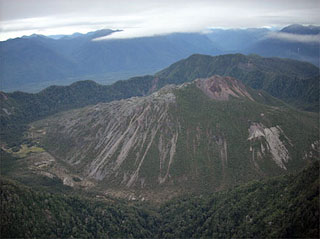Report on Chaiten (Chile) — 30 September-6 October 2009
Smithsonian Institution / US Geological Survey
Weekly Volcanic Activity Report, 30 September-6 October 2009
Managing Editor: Sally Sennert.
Please cite this report as:
Global Volcanism Program, 2009. Report on Chaiten (Chile) (Sennert, S, ed.). Weekly Volcanic Activity Report, 30 September-6 October 2009. Smithsonian Institution and US Geological Survey.
Chaiten
Chile
42.8349°S, 72.6514°W; summit elev. 1122 m
All times are local (unless otherwise noted)
During 16-30 September, SERNAGEOMIN reported that Chaitén's Domo Nuevo 1 (Phase I) and Domo Nuevo 2 (Phase II) lava-dome complex continued to grow, generating block-and-ash flows from the collapse of unstable slopes. Gas plumes continued to rise from the complex and were visible using the web camera, S of the volcano.
On 29 September, people living in Chaitén town, 10 km SW, noticed that the eruption column was larger. A dark area in the plume seen on the web camera was interpreted to possibly be from collapse of part of the lava dome to the SW. Scientists conducted an overflight and saw a third lava dome (Phase III) in the SW area of the complex, which had filled up a depression left by a collapse on 19 February. They also noted a NNW-trending depression along the center of the lava domes with spines at the N end, and that the central spine complex had disappeared. Ash-and-gas plumes that occasionally rose 2 km above the lava domes had two sources: one from the new dome and one from the central depression. Several parts of the depressions circling the lava domes had been filled in by collapsed material, and the depositional area near the mouth of the Blanco River had also grown.
Based on web camera views, SIGMET notices, and analyses of satellite imagery, the Buenos Aires VAAC reported that on 30 September and 3 October diffuse ash plumes, possibly mixed with steam and gas, rose to an altitude of 2.4 km (8,000 ft) a.s.l. and drifted as far away as 55 km SE.
Geological Summary. Chaitén is a small caldera (~3 km in diameter) located 10 km NE of the town of Chaitén on the Gulf of Corcovado. Multiple explosive eruptions throughout the Holocene have been identified. A rhyolitic obsidian lava dome occupies much of the caldera floor. Obsidian cobbles from this dome found in the Blanco River are the source of artifacts from archaeological sites along the Pacific coast as far as 400 km from the volcano to the N and S. The caldera is breached on the SW side by a river that drains to the bay of Chaitén. The first recorded eruption, beginning in 2008, produced major rhyolitic explosive activity and building a new dome and tephra cone on the older rhyolite dome.
Sources: Servicio Nacional de Geología y Minería (SERNAGEOMIN), Buenos Aires Volcanic Ash Advisory Center (VAAC)

